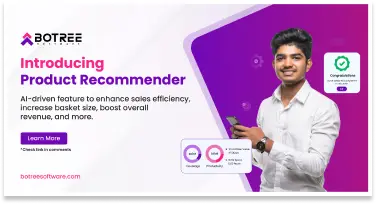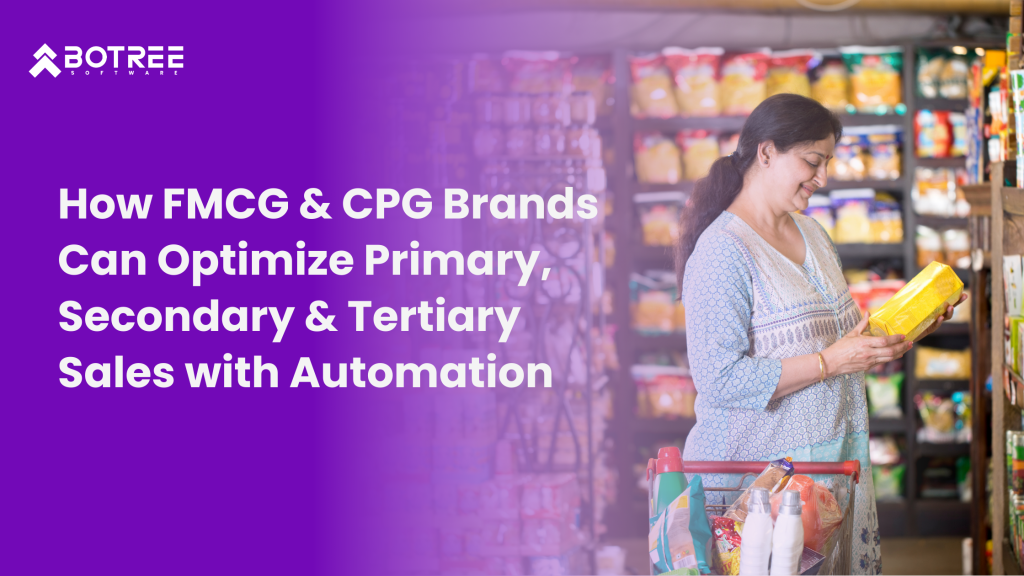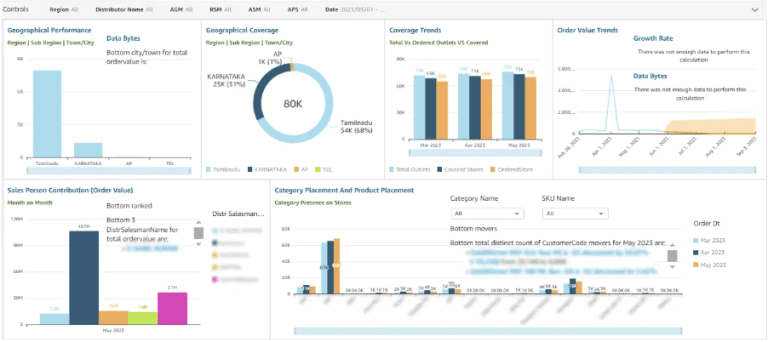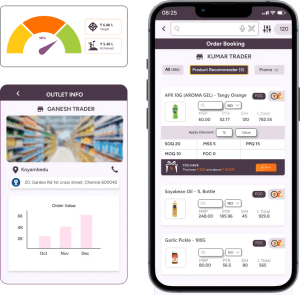
Power Up Your Operations with the Latest Botree DMS Updates
From Secure GRNs to Dynamic Reporting: What’s New in Botree

From Secure GRNs to Dynamic Reporting: What’s New in Botree

Introducing the AI-Driven Product Recommender to Maximize Basket Size at Every Outlet
We are thrilled to introduce our latest innovation, the Product Recommender, designed to transform the way businesses optimize their product offerings and enhance sales productivity.

Sales success isn’t just about having the right strategies — it’s about execution. In FMCG and CPG, primary, secondary, and tertiary sales work together to move products from manufacturers to distributors to retailers, and finally, consumers.
When one stage is optimized, it strengthens the next, driving continuous growth. But if one falters — whether it’s a delay in distributor orders, a stockout at retail, or poor consumer engagement — the entire chain feels the impact.
That’s where technology comes in. With the right tools, you’re not just improving each stage individually — you’re ensuring they work in sync. Automated stock tracking, AI-driven demand forecasting, and real-time sales insights help brands optimize execution across all three sales levels and ensure each stage fuels the next for sustained growth.

In this article, we’ll be exploring how you can use technology to execute your sales strategies and optimize sales at all stages.
Getting FMCG and CPG products into consumers’ hands isn’t as simple as it seems. With multiple layers of sales, shifting market demands, and logistical hurdles — there are plenty of interconnected elements that can impact sales execution across the distribution chain.
Here’s a quick look at the many challenges you’re likely to face when executing your primary, secondary, and tertiary sales strategies.
Primary sales (brand to distributor) | Secondary sales (distributor to retailer) | Tertiary sales (retailer to consumer |
Demand-supply mismatches: When consumer demand shifts, it can throw production off balance. Without accurate forecasting, brands may end up with too much or too little stock, resulting in lost sales or excess inventory. | Stockouts: Unpredictable demand and poor communication between distributors and retailers make it difficult to maintain optimal stock levels, especially if brands don’t have secondary data visibility on distributor sales. | Unstructured promotions: Gaps in communication between brands, distributors, and retailers and a lack of standardized processes can lead to inconsistent or poorly executed retail promotions. |
Forecasting errors: Demand forecasting relies on multiple factors — historical sales data, market trends, and external influences like seasonality. Without advanced analytics and real-time insights, predicting production and inventory needs becomes challenging. | Inefficient order tracking: Managing orders across multiple channels is complex. Many brands still rely on outdated or fragmented systems, making it hard to track orders in real time and address stock issues early. | Limited visibility into consumer demand: Many brands lack real-time data on purchasing behavior, making it tough to adjust marketing efforts. Without these insights, responding to consumer preferences becomes a guessing game. |
Lack of visibility: Without clear visibility into stock levels across the supply chain, companies struggle to balance inventory, leading to fulfillment delays and inefficient replenishment. | Weak retailer engagement: Retailers manage multiple brands. This means they prioritize those that offer better support, incentives, and sales insights. But doing this consistently for hundreds — if not thousands — of retailers can get complex. | Gaps in market knowledge: Analyzing trends is tricky without the right data tools. And when brands can’t track emerging trends or seasonal shifts, they miss out on key opportunities to run promotions and boost sales. |
Weak distribution networks: Without a strong (and well-coordinated) distribution network, brands may struggle to expand into new regions or keep up with demand in high-growth areas. |
We’ve seen how challenges like poor visibility, misaligned promotions, and inconsistent order fulfillment can hold back sales execution at every stage. While having a strong sales strategy is essential, the real challenge lies in executing it consistently across your entire distribution network.
Take promotions, for instance — you may design attractive schemes for retailers, but without proper communication and tracking, many miss out. Similarly, saying “produce for demand” is easy, but accurately predicting demand? Not so much. It doesn’t have to be this way.
The solution? Automating sales execution. This helps turn strategy into action by streamlining key processes and keeping everything on track. Here’s how:
Put simply, with automation, sales execution becomes smoother, smarter, and more scalable.
Real-world case study: Royal Canin, a global pet food brand with 100+ distributors in India, was struggling to keep up with data and inventory levels. Relying on manual processes led to frequent errors, operational inefficiencies, and limited visibility — making it difficult to track unbilled outlets, monitor stock availability, and ensure smooth distribution across its network.
With Botree DMS, they turned things around. Automated stock tracking removed mismatches, real-time data cut down errors, and better visibility made decision-making easier.
And they’re not stopping there. Royal Canin is integrating Botree DMS with their ERP, online shop, and veterinary partner management system — bringing all their order data into one place, streamlining inventory management, and building a fully connected distribution chain.
Discover how Royal Canin transformed its distribution with Botree DMS.
Now that we’ve explored how sales automation helps FMCG and CPG brands overcome challenges at each stage of the sales process, let’s explore how exactly you can drive effective execution on the ground.
Boosting primary sales starts with your distributors, and the right technology makes all the difference. Distributor Management Software (DMS) can streamline operations and improve visibility across the distribution chain — ensuring better stock management and keeping your sales momentum strong. Here’s how —
To start with, DMS software can help you automate critical processes like order management, invoicing, claims settlement, and tax compliance, reducing manual errors and improving efficiency. This means distributors can process orders faster, ensure timely stock replenishment, and stay compliant with minimal effort.
Similarly, DMS software gives you real-time visibility into inventory levels, preventing both overstocking and stockouts. This ensures a steady supply to distributors (and retailers) while also freeing up working capital that would otherwise be tied up in slow-moving or dead stock.
For example, with Botree DMS, you will be able to:
DMS software — typically powered by AI — can analyze your historical and real-time sales patterns to accurately predict demand. This helps you align supply with actual demand, minimizing stockouts, overstocking, and wastage.
With software like Botree DMS, you’ll get reports that can help you:
These insights can help with better demand forecasting, allowing you to optimize inventory and make proactive, data-driven decisions to meet market needs.

For FMCG and CPG products — especially those with short shelf lives — last-mile visibility is a must to ensure timely delivery and prevent spoilage or expiration. And for this, you need sales force automation software (like Botree SFA), which allows you to streamline field sales operations, optimize shelf displays, and connect with retailers.
In fact, Nabati — a global indulgent snacking brand — believes the last-mile visibility and data-driven insights provided by Botree SFA to be a key reason why they became the largest distributed wafer cream biscuit brand in India within a short two years.
Here’s how you can enhance your secondary sales with SFA:
Efficient beat planning ensures that your field sales team visits the right outlets at the right time — maximizing coverage and minimizing missed opportunities. With solutions like Botree SFA, you can:
For secondary sales, retail execution is just as important as field sales operations because retailers are the final link between your product and the consumer. Even if your field sales team is efficient in getting orders placed, poor execution at the retail level — like improper shelf placement, stockouts, or unappealing displays — can lead to lost sales opportunities.
Using SFA, you can guide your sales team to ensure planogram adherence so store layouts remain consistent, improving brand visibility and customer experience. Here’s how the merchandiser module in SFA can help;
Integrate your distributor management and sales force automation platforms
By connecting SFA with DMS, FMCG and CPG companies can bridge the gap between primary and secondary sales. Knowing what’s selling at the retail level (through SFA) allows for more accurate forecasting of distributor orders (tracked in DMS). This allows for a more accurate understanding of true market demand and better production planning.
Finally, let’s explore how to improve your tertiary sales. And the best way to do this is by building strong retailer relationships using technology.
Technology — like DMS, SFA, and retailer management apps — can all significantly improve retailer satisfaction. Some ways they support brands in engaging retailers are:
Case in point: When Amul onboarded their retailers to the Botree Retailer App, they found a 40% increase in orders during off-peak hours. This proved retailers preferred placing purchase orders outside of business hours. The app also helped retailers:
The result: Amul’s products are always stocked at retail outlets.
Another area where technology can benefit retailers is helping them figure out what to stock up on, and if they should broaden their product assortment. There are two ways to address this:

Finally, let’s quickly go over the many ways that tech-powered sales execution can improve sales team efficiency and your profit margins.
Winning in FMCG and CPG requires seamless execution across primary, secondary, and tertiary sales. With Botree Software, you get the tools to automate order processing, optimize field sales, and strengthen retailer relationships — all while ensuring real-time data sync across your distribution network.
Botree Software’s fully integrated DMS, SFA, Retailer, and Analytics solutions give you:
The result? Faster sales cycles, better stock management, and a future-proof strategy to stay ahead of the competition.
Curious to learn more? Talk to our team to see how you can leverage Botree Software’s suite of products to automate your FMCG and CPG sales and build better relationships with both distributors and retailers.
Meet Priyanka Allu, our in-house content marketing specialist. With a background in literature and communications, Priyanka brings in her expertise in crafting compelling brand narratives and engaging content across various marketing channels. Outside of work, you can find her quickly escaping from the mundane city life by the beach or mountains, spending quality time with loved ones.
